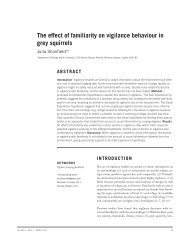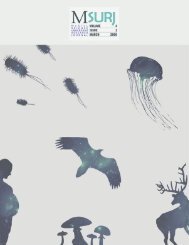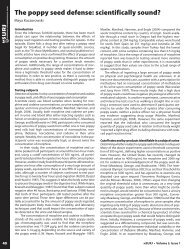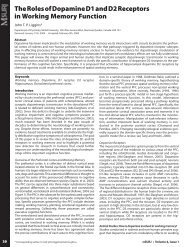the entire issue - McGill Science Undergraduate Research Journal ...
the entire issue - McGill Science Undergraduate Research Journal ...
the entire issue - McGill Science Undergraduate Research Journal ...
Create successful ePaper yourself
Turn your PDF publications into a flip-book with our unique Google optimized e-Paper software.
REVIEW ARTICLE<br />
Autosomal Recessive Spastic Ataxia of<br />
Charlevoix-Saguenay (ARSACS): a once obscure<br />
neurodegenerative disease with increasing<br />
significance for neurological research<br />
Xinlu (Crystal) Li 1 *<br />
1<br />
Department of Biochemistry, <strong>McGill</strong> University, Montreal, QC<br />
*Email Correspondence:<br />
xinlu.li@mail.mcgill.ca<br />
Keywords:<br />
Autosomal Recessive Spastic Ataxia of<br />
Charlevoix-Saguenay (ARSACS): A complex<br />
early-onset neurodegenerative disease found<br />
in high prevalence in <strong>the</strong> population of <strong>the</strong><br />
Charlevoix-Saguenay region in Quebec due to<br />
founder effect.<br />
Founder Effect: Significant reduction in genetic<br />
variability and increase in homozygosity level in<br />
a population descending from a small founder<br />
population geographically isolated from its<br />
ancestral population.<br />
Chaperones: Important protein-folding quality<br />
control machineries that promote and maintain<br />
<strong>the</strong> proper folding of cellular proteins and target<br />
misfolded proteins for degradation.<br />
Mitochondrial Fission/Fusion Dynamics: The<br />
delicate balance between <strong>the</strong> fission and fusion<br />
of mitochondria that is essential for its quality<br />
control, function and distribution in <strong>the</strong> cell.<br />
Abstract<br />
Background: Autosomal Recessive Spastic Ataxia of Charlevoix-Saguenay (ARSACS) is a<br />
rare cerebellar ataxia occurring in <strong>the</strong> Charlevoix-Saguenay population in Quebec with high<br />
incidence as a result of founder effects. Following <strong>the</strong> discovery of <strong>the</strong> gene responsible for <strong>the</strong><br />
disease, many o<strong>the</strong>r patient groups have been identified worldwide and <strong>the</strong> characterization<br />
of <strong>the</strong> gene product, sacsin, has unveiled similarities between <strong>the</strong> pathogenic mechanism of<br />
ARSACS and those of o<strong>the</strong>r major neurodegenerative disease.<br />
Summary: The core symptoms of ARSACS consist of a triad of early-onset cerebellar ataxia,<br />
peripheral neuropathy and spasticity, which is accounted by degeneration of Purkinje<br />
neurons. The gene responsible for <strong>the</strong> disease is located on chromosome 13q11 and encodes<br />
for <strong>the</strong> chaperone sacsin. Drp-1, a GTPase crucial for regulating mitochondrial fission/fusion<br />
dynamics, has been identified as a potential substrate of sacsin, suggesting a link between<br />
<strong>the</strong> pathogenic mechanisms of ARSACS and prevalent neurodegenerative diseases such as<br />
Alzheimer’s, Parkinson’s and Huntington’s diseases.<br />
Autosomal recessive spastic ataxia of Charlevoix-Saguenay (ARSACS)<br />
is a complex hereditary neurodegenerative disorder characterized<br />
by a triad of early childhood-onset cerebellar ataxia (uncoordinated<br />
movements due to defects in <strong>the</strong> cerebellum (1)), peripheral neuropathy<br />
(peripheral nerve damages resulting in a variety of sensorimotor<br />
symptoms (2)) and pyramidal tract signs (traits such as spasticity, abnormal<br />
reflexes and loss of ability to perform fine motor movements<br />
due to defects in <strong>the</strong> neurons relaying signals from <strong>the</strong> cerebral cortex<br />
or midbrain to <strong>the</strong> spinal cord (3)) (4). The disease was initially<br />
named after its high incidence in <strong>the</strong> French-Canadian population<br />
of Charlevoix-Saguenay region in nor<strong>the</strong>astern Quebec as a result of<br />
founder effect (5) but was later also discovered in many o<strong>the</strong>r regions<br />
and ethnic groups worldwide (6). SACS, <strong>the</strong> gene whose mutations<br />
are responsible for <strong>the</strong> ARSACS’ symptoms, was identified by Engert<br />
et al. in 2000(7). The gene product, sacsin, constitutes one of <strong>the</strong><br />
largest known human proteins and bioinformatics and biochemical<br />
characterizations of peptide domains in sacsin suggest that it performs<br />
its cellular function by integrating <strong>the</strong> ubiquitin-proteasome<br />
system and <strong>the</strong> chaperone pathways (6). Fur<strong>the</strong>rmore, a recent study<br />
of a transgenic sacsin-knockout mouse model associated <strong>the</strong> loss of<br />
sacsin’s function with <strong>the</strong> disruption in neuronal mitochondrial fission/fusion<br />
dynamics (8). This finding in turn significantly elevated<br />
<strong>the</strong> research significance of ARSACS, since <strong>the</strong> disruption in neuronal<br />
mitochondrial dynamics underlies many prevalent neurodegenerative<br />
disorders such as Alzheimer’s, Parkinson’s and Huntington’s diseases<br />
(9). Therefore, <strong>the</strong> purpose of this review is to delineate major<br />
clinical, genetic and biochemical findings on ARSACS to highlight <strong>the</strong><br />
increasing research significance of this once obscure disease.<br />
Volume 8 - Issue 1 - March 2013 69









